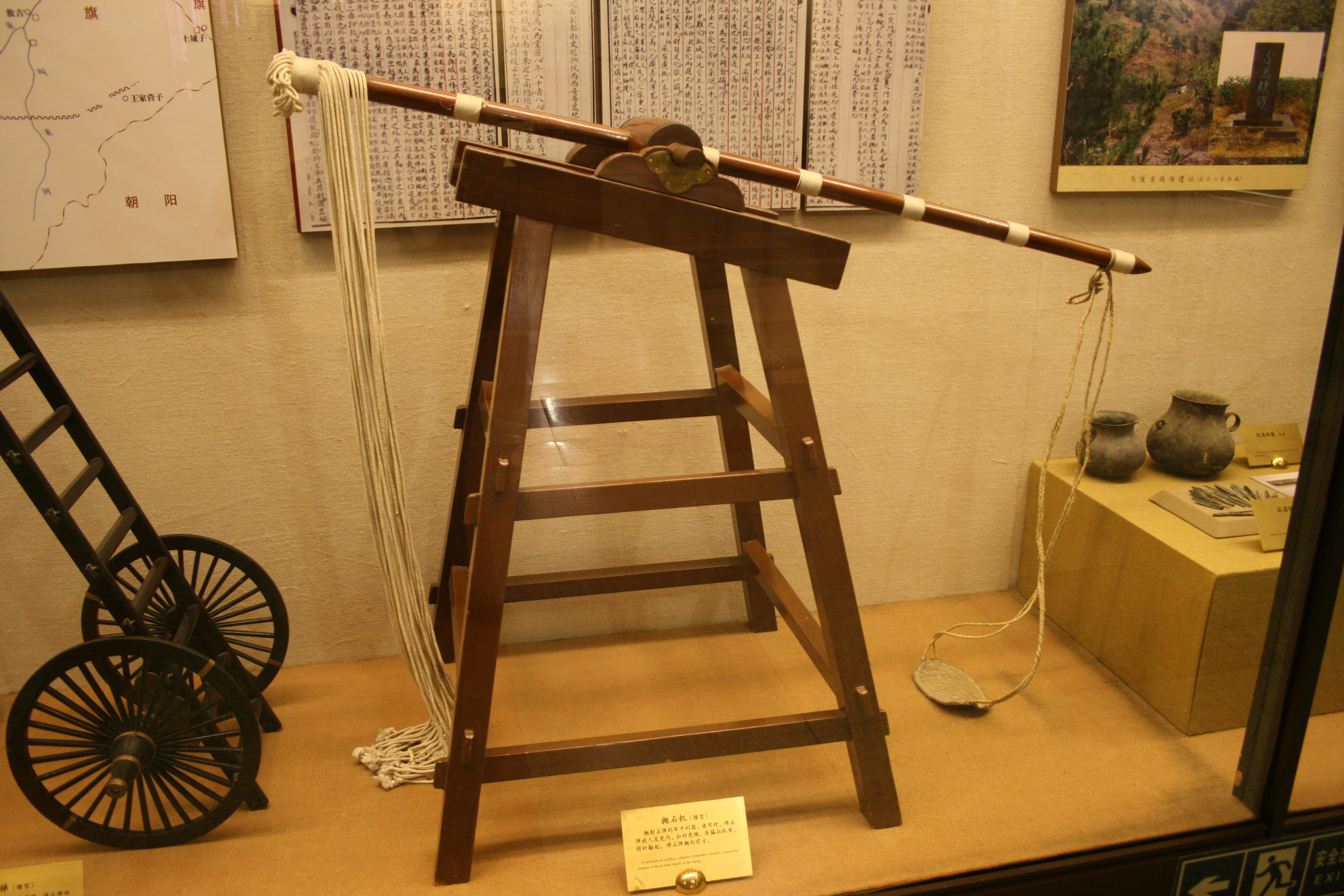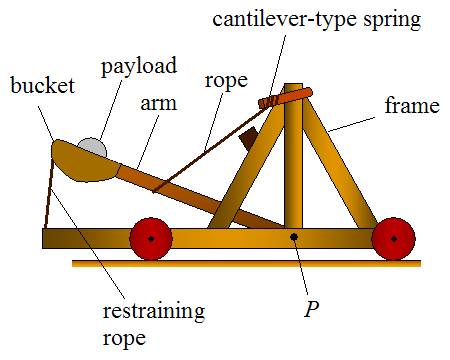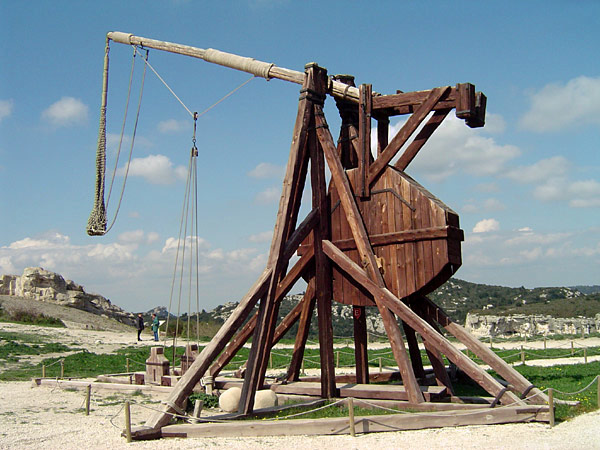|
Trebuchet
A trebuchet () is a type of catapult that uses a hinged arm with a sling attached to the tip to launch a projectile. It was a common powerful siege engine until the advent of gunpowder. The design of a trebuchet allows it to launch projectiles of greater weights and further distances than a traditional catapult. There are two main types of trebuchet. The first is the ''traction trebuchet'', or mangonel, which uses manpower to swing the arm. It first appeared in China by the 4th century BC. It spread westward, possibly via the Avars, and was adopted by the Byzantines, Persians, Arabs, and other neighboring peoples by the sixth to seventh centuries AD. The later, and often larger and more powerful, counterweight trebuchet, also known as the counterpoise trebuchet, uses a counterweight to swing the arm. It appeared in both Christian and Muslim lands around the Mediterranean in the 12th century, and was carried back to China by the Mongols in the 13th century. "Although this is ... [...More Info...] [...Related Items...] OR: [Wikipedia] [Google] [Baidu] |
Mangonel
The mangonel, also called the traction trebuchet, was a type of trebuchet used in Ancient China starting from the Warring States period, and later across Eurasia by the 6th century AD. Unlike the later counterweight trebuchet, the mangonel was operated by people pulling ropes attached to one end of a lever, the other end of which had a sling to launch projectiles. Although the mangonel required more men to function, it was also less complex and faster to reload than the torsion-powered onager which it replaced in early Medieval Europe. It was replaced as the primary siege weapon in the 12th and 13th centuries by the counterweight trebuchet.Chevedden, Paul E.; et al. (July 1995). "The Trebuchet". Scientific American: 66–71. http://static.sewanee.edu/physics/PHYSICS103/trebuchet.pdf . Original version. A common misconception about the mangonel is that it was a torsion siege engine. Etymology The word ''mangonel'' was first attested in English in the 13th century, it is borr ... [...More Info...] [...Related Items...] OR: [Wikipedia] [Google] [Baidu] |
Catapult
A catapult is a ballistics, ballistic device used to launch a projectile at a great distance without the aid of gunpowder or other propellants – particularly various types of ancient and medieval siege engines. A catapult uses the sudden release of stored potential energy to propel its payload. Most convert Tension (mechanics), tension or Torsion (mechanics), torsion energy that was more slowly and manually built up within the device before release, via springs, bows, twisted rope, elastic, or any of numerous other materials and mechanisms which allow the catapult to launch a projectile such as rocks, cannon balls, or debris. During wars in the ancient times, the catapult was usually known to be the strongest heavy weaponry. In modern times the term can apply to devices ranging from a simple hand-held implement (also called a "slingshot") to a mechanism for Aircraft catapult, launching aircraft from a ship. The earliest catapults date to at least the 7th century BC, with Kin ... [...More Info...] [...Related Items...] OR: [Wikipedia] [Google] [Baidu] |
Sling (weapon)
A sling is a projectile weapon typically used to hand-throw a blunt projectile such as a stone, clay, or lead " sling-bullet". It is also known as the shepherd's sling or slingshot (in British English, although elsewhere it means something else). Someone who specializes in using slings is called a slinger. A sling has a small cradle or ''pouch'' in the middle of two retention cords, where a projectile is placed. There is a loop on the end of one side of the retention cords. Depending on the design of the sling, either the middle finger or the wrist is placed through a loop on the end of one cord, and a tab at the end of the other cord is placed between the thumb and forefinger. The sling is swung in an arc, and the tab released at a precise moment. This action releases the projectile to fly inertially and ballistically towards the target. By its double-pendulum kinetics, the sling enables stones (or spears) to be thrown much further than they could be by hand alone. ... [...More Info...] [...Related Items...] OR: [Wikipedia] [Google] [Baidu] |
Counterweight
A counterweight is a weight (object), weight that, by applying an opposite force, provides balance and stability of a machine, mechanical system. The purpose of a counterweight is to make lifting the load faster and more efficient, which saves energy and causes less wear and tear on the lifting machine. Counterweights are often used in traction force, traction elevator, lifts (elevators), Crane (machine), cranes and fair, funfair rides. In these applications, the expected load multiplied by the distance that load will be spaced from the central support (called the "tipping point") must be equal to the counterweight's mass times its distance from the tipping point in order to prevent over-balancing either side. This distance times mass is called the Moment (physics), load moment. By extension, a counterbalance force balances or offsets another force, as when two objects of equal weight, power, or influence are acting in opposition to each other. Examples ;Trebuchet: There are fi ... [...More Info...] [...Related Items...] OR: [Wikipedia] [Google] [Baidu] |
Potential Energy
In physics, potential energy is the energy of an object or system due to the body's position relative to other objects, or the configuration of its particles. The energy is equal to the work done against any restoring forces, such as gravity or those in a spring. The term ''potential energy'' was introduced by the 19th-century Scottish engineer and physicist William Rankine, although it has links to the ancient Greek philosopher Aristotle's concept of Potentiality and Actuality, ''potentiality''. Common types of potential energy include gravitational potential energy, the elastic potential energy of a deformed spring, and the electric potential energy of an electric charge and an electric field. The unit for energy in the International System of Units (SI) is the joule (symbol J). Potential energy is associated with forces that act on a body in a way that the total Work (physics), work done by these forces on the body depends only on the initial and final positions of the b ... [...More Info...] [...Related Items...] OR: [Wikipedia] [Google] [Baidu] |
Byzantine Empire
The Byzantine Empire, also known as the Eastern Roman Empire, was the continuation of the Roman Empire centred on Constantinople during late antiquity and the Middle Ages. Having survived History of the Roman Empire, the events that caused the fall of the Western Roman Empire in the 5th centuryAD, it endured until the fall of Constantinople to the Ottoman Empire in 1453. The term 'Byzantine Empire' was coined only after its demise; its citizens used the term 'Roman Empire' and called themselves 'Romans'. During the early centuries of the Roman Empire, the western provinces were Romanization (cultural), Latinised, but the eastern parts kept their Hellenistic culture. Constantine the Great, Constantine I () legalised Christianity and moved the capital to Constantinople. Theodosius I, Theodosius I () made Christianity the state religion and Greek gradually replaced Latin for official use. The empire adopted a defensive strategy and, throughout its remaining history, expe ... [...More Info...] [...Related Items...] OR: [Wikipedia] [Google] [Baidu] |
Iohannes Codagnellus
Giovanni Codagnello ( – after 1235) was an Italian notary and historian. Life Codagnello was born around 1154 in Piacenza. His surname was sometimes Latinized as ''Caputagni''. Between 1199 and 1230, he is attested as a notary in documents from Piacenza and Cremona as both certifier and witness. He was for a time the ''pro tempore'' notary of the government of Piacenza.; . On 31 March 1202, he drew up a treaty of peace between, on the one side, Piacenza and Milan and, on the other, Pavia. In 1222, he witnessed a charter in Fiorenzuola d'Arda. In 1226, Codagnello campaigned for the restoration of the Lombard League and Piacenza's joining it. He is best known for his collection of historical writings in Latin. Altogether these cover the history of the world from the Great Flood down to 1235. It is probable that Codagnello spent the years 1230–1235 working on his history and died not long after. Works Codagnello identifies himself as the author and compiler in some verses at the ... [...More Info...] [...Related Items...] OR: [Wikipedia] [Google] [Baidu] |
Force
In physics, a force is an influence that can cause an Physical object, object to change its velocity unless counterbalanced by other forces. In mechanics, force makes ideas like 'pushing' or 'pulling' mathematically precise. Because the Magnitude (mathematics), magnitude and Direction (geometry, geography), direction of a force are both important, force is a Euclidean vector, vector quantity. The SI unit of force is the newton (unit), newton (N), and force is often represented by the symbol . Force plays an important role in classical mechanics. The concept of force is central to all three of Newton's laws of motion. Types of forces often encountered in classical mechanics include Elasticity (physics), elastic, frictional, Normal force, contact or "normal" forces, and gravity, gravitational. The rotational version of force is torque, which produces angular acceleration, changes in the rotational speed of an object. In an extended body, each part applies forces on the adjacent pa ... [...More Info...] [...Related Items...] OR: [Wikipedia] [Google] [Baidu] |
Siege Engine
A siege engine is a device that is designed to break or circumvent heavy castle doors, thick city walls and other fortifications in siege warfare. Some are immobile, constructed in place to attack enemy fortifications from a distance, while others have wheels to enable advancing up to the enemy fortification. There are many distinct types, such as siege towers that allow foot soldiers to scale walls and attack the defenders, battering rams that damage walls or gates, and large ranged weapons (such as ballistas, catapults/ trebuchets and other similar constructions) that attack from a distance by launching heavy projectiles. Some complex siege engines were combinations of these types. Siege engines are fairly large constructions – from the size of a small house to a large building. From antiquity up to the development of gunpowder, they were made largely of wood, using rope or leather to help bind them, possibly with a few pieces of metal at key stress points. They could la ... [...More Info...] [...Related Items...] OR: [Wikipedia] [Google] [Baidu] |






